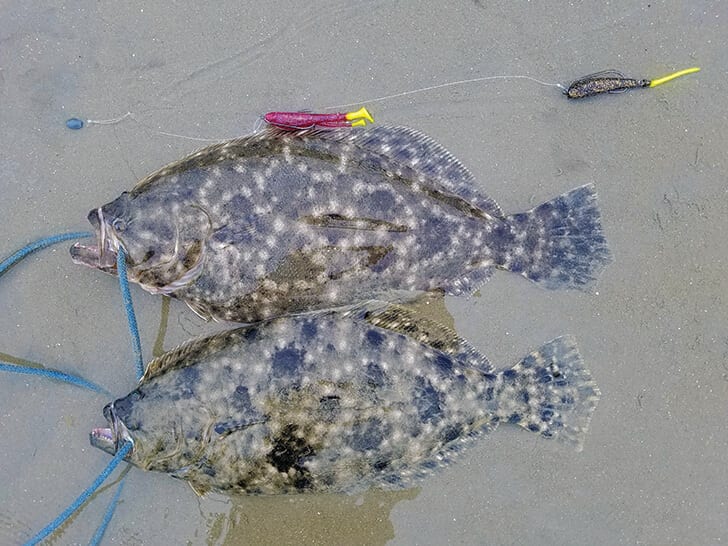
Here are some tips on catching flounder that some might not have tried. The technique I am about to share has some benefits over the more mainstream methods. It is also so simple and easy to use. I rig my son’s rod this way.
When the topic of flounder fishing is mentioned, the main issues I hear are when to set the hook and difficulty in getting a good hook set. I know there are different theories such as, count to three, count to 10, or set the hook immediately. With this method, I set the hook immediately, still get a solid hook set and injure fewer fish, which is important if you’re releasing them.
The method I want to share is a tandem Carolina rig. Here is the quick easy way I tie it. Cut 30 inches of 30-lb. mono. Fold your line together and tie an overhand knot leaving two uneven lengths of leader, one about 20 inches, the other 10 inches. Leave a loop in the overhand knot when it’s cinched. Add a barrel weight to your main line and attach it to the loop. Next, tie un-weighted screw-lock swimbait hooks to each end, and rig your lures weedless. I have found that lures that can float with the hook in them outperform a lure that sinks to the bottom and sits there motionless. With a floating lure, the waves and current keep the lure moving even when you pause. This results in more action and therefore more strikes.
The main advantage to the tandem Carolina rig is the lures are not weighted, and they are free moving due to a slip weight. When the flounder inhales the lure, there is less resistance from the weight, and the lure goes deeper into the fish’s mouth. No tail grabs and short strikes to worry about. That is why I set the hook immediately. This is also what makes it easy enough for even kids to get a solid hook set.
While targeting flounder, I also like to work my rod to the side with a low twitching motion to keep the lure or weight dragging on the bottom rather than bouncing it, as I would when targeting trout. Kicking up a steady trail of dust can attract the fish, and when you pause and the lure starts to rise, it is a livelier presentation.
The length of the leader, distance between hooks, and the weight is a personnel preference. Some may also add a glass bead or two between the swivel or leader knot and the egg weight to give a little click. To keep it simple and quick, I don’t always use a swivel. I might just tie a large loop knot in my leader, and the egg weight will rest against the knot. Adding scent to your lures is also a great addition when targeting flounder.
Head out to your favorite flounder hole, and give the tandem Carolina rig a try. I think you will be impressed with the results.
Capt. Michael Okruhlik is the inventor of Controlled Descent Lures and the owner of www.MyCoastOutdoors.com.